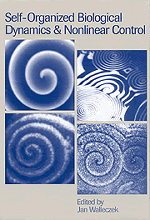 Self-Organized Biological Dynamics and Nonlinear Control
Self-Organized Biological Dynamics and Nonlinear Control Book contents
- Frontmatter
- Contents
- List of contributors
- Preface
- The frontiers and challenges of biodynamics research
- Part I Nonlinear dynamics in biology and response to stimuli
- Part II Nonlinear sensitivity of biological systems to electromagnetic stimuli
- Part III Stochastic noise-induced dynamics and transport in biological systems
- 10 Stochastic resonance: looking forward
- 11 Stochastic resonance and small-amplitude signal transduction in voltage-gated ion channels
- 12 Ratchets, rectifiers, and demons: the constructive role of noise in free energy and signal transduction
- 13 Cellular transduction of periodic and stochastic energy signals by electroconformational coupling
- Part IV Nonlinear control of biological and other excitable systems
- Index
13 - Cellular transduction of periodic and stochastic energy signals by electroconformational coupling
Published online by Cambridge University Press: 14 August 2009
- Frontmatter
- Contents
- List of contributors
- Preface
- The frontiers and challenges of biodynamics research
- Part I Nonlinear dynamics in biology and response to stimuli
- Part II Nonlinear sensitivity of biological systems to electromagnetic stimuli
- Part III Stochastic noise-induced dynamics and transport in biological systems
- 10 Stochastic resonance: looking forward
- 11 Stochastic resonance and small-amplitude signal transduction in voltage-gated ion channels
- 12 Ratchets, rectifiers, and demons: the constructive role of noise in free energy and signal transduction
- 13 Cellular transduction of periodic and stochastic energy signals by electroconformational coupling
- Part IV Nonlinear control of biological and other excitable systems
- Index
Summary
Introduction
The transport of life-sustaining materials across the cell membrane consumes large fractions of the total energy expenditures of cells. As such, membrane transport is tightly regulated and controlled. Membrane proteins are mostly responsible for the transport of molecules and ions in and out of the cell. There are many classes of membrane transporters. A simple classification lists three types: channels, carriers and pumps. Channels and carriers are passive downhill transporters, whereas pumps are active uphill transporters. However, a channel may also be able to fulfill the role of an uphill transporter by coupling a downhill transport reaction to an uphill transport reaction: the transporter, however, will still be a downhill transporter overall. Beside proteins, a small number of transporters come from heterocyclic organic compounds. These small molecules can serve as ion channels or ion carriers, but only a protein with enzymatic activity can function as a pump. All transporters are embedded in lipid bilayers and, for a pump to function, some degrees of freedom must be hindered or restricted. As I shall discuss later, this feature of a pump is crucial for capturing energy from a periodically oscillating or randomly fluctuating force field (Tsong and Astumian, 1986, 1988; Tsong, 1990, 1992).
In order for a pump to capture energy another feature is essential: it must be able to interact effectively with a driving force, e.g., an electric field or an acoustic field (Tsong and Astumian, 1986, 1988).
- Type
- Chapter
- Information
- Self-Organized Biological Dynamics and Nonlinear ControlToward Understanding Complexity, Chaos and Emergent Function in Living Systems, pp. 301 - 326Publisher: Cambridge University PressPrint publication year: 2000


